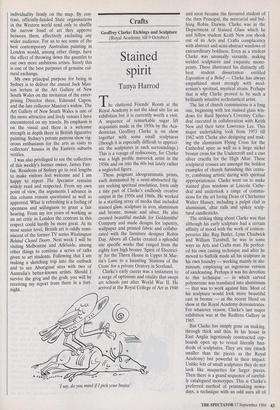Crafts
Stained spirit
Tanya Harrod
The cluttered Friends' Room at the Royal Academy is not the ideal site for an exhibition but it is currently worth a visit. A sequence of remarkable sugar lift acquatints made in the 1950s by the Aca- demician Geoffrey Clarke is on show together with some small sculptures (though it is especially difficult to appreci- ate the sculptures in such surroundings.) This is a voyage of rediscovery, for Clarke was a high profile maverick artist in the 1950s and on into the 60s but lately rather a neglected figure. These poignant ideogrammatic prints, each dominated by a semi-abstracted fig- ure seeking spiritual resolution, form only a tiny part of Clarke's endlessly creative output in the 1950s and 1960s. He worked in a startling array of media that included stained glass, sculpture in iron, aluminium and bronze, mosaic and silver. He also created beautiful medals for Goldsmiths' Company and made designs for tapestry, wallpaper and printed fabric and collabo- rated with the furniture designer Robin Day. Above all Clarke created a splendid site specific works that ranged from the eighty foot high bronze 'Spirit of Electrici- ty' for the Thorn House in Upper St Mar- tin's Lane to a haunting 'Stations of the Cross' for a private Oratory in Scotland.
Clarke's early career was a testament to a surge of optimism and vitality that swept art schools just after World War II. He arrived at the Royal College of Art in 1948 'I say, do you mind if l pick your brains' and soon became the favoured student of the then Principal, the mercurial and bul- lying Robin Darwin. Clarke was in the Department of Stained Glass which he and fellow student Keith New son shook out of its Arts and Crafts complacency with abstract and semi-abstract windows of extraordinary boldness. Even as a student Clarke was unusually versatile, making welded sculptures and exquisite mono- prints. These illustrated his distinctly off- beat student dissertation entitled Exposition of a Belief — Clarke has always empathised most strongly with mod- ernism's spiritual, mystical strain. Perhaps that is why Clarke proved to be such a brilliantly intuitive ecclesiastical artist.
The list of church commissions is a long one, beginning with ten stained glass win- dows for Basil Spence's Coventry Cathe- dral executed in collaboration with Keith New and their tutor Lawrence Lee. This major undertaking took from 1953 till 1962 with Clarke also designing and mak- ing the aluminium Flying Cross for the Cathedral spire as well as a large nickel bronze cross for the Undercroft and a cast silver crucifix for the High Altar. These sculptural crosses are amongst the boldest examples of church furnishing this centu- ry, combining artistic daring with spiritual appropriateness. Clarke went on to make stained glass windows at Lincoln Cathe- dral and undertook a range of commis- sions for the art loving Dean of Chichester Walter Hussey, including a pulpit clad in aluminium, altar rails and spikey sculp- tural candlesticks.
The striking thing about Clarke was that although his early sculpture had a certain affinity of mood with the work of contem- poraries like Reg Butler, Lynn Chadwick and William Turnbull, he was in some ways an Arts and Crafts man. He perfect- ed his own casting technique and after he moved to Suffolk made all his sculpture in his own foundry — working mainly in alu- minium, employing an ingenious version of sandcasting. Perhaps it was his devotion to this technique — in which carved polysterene was translated into aluminium — that was to work against him. Most of his sculpture would look more beautiful cast in bronze — as the recent Head on show at the Royal Academy demonstrates. For whatever reason, Clarke's last major exhibition was at the Redfern Gallery in 1965.
But Clarke has simply gone on making, through thick and thin. In his house in East Anglia ingeniously constructed cup- boards open up to reveal literally hun- dreds of sculptures. They are tiny (much smaller than the pieces as the Royal Academy) but powerful in their impact. Unlike lots of small sculptures they do not look like maquettes for larger pieces. Then there is a grand sequence of careful- ly catalogued monotypes. This is Clarke's preferred method of printmaking nowa- days, a technique with an odd aura all of its own, hovering between the fragility of a drawing and the resolution of all print processes. Most of these monotypes are ideas for sculpture and form an awe inspiring document of one man's imagina- tive pilgrimage.
In recent years one senses this has been a rather lonely pilgrimage and a testament to Clarke's brave tenacity. But this spring he had a small retrospective at the York- shire Sculpture Park. Indeed years of neglect of this fascinating artist seem about to be redressed; the present show at the Royal Academy will be followed by a major retrospective at Ipswich Museum in December which will tour to Coventry and Chichester. Let us hope this will include a proper documentation of his early career and a generous selection of recent work, particularly his prints and those haunting small sculptures.



























































 Previous page
Previous page